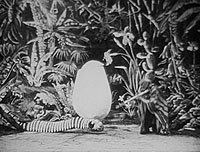6 /10 1 Votes6
6.4/10 Letterboxd Release date 1901 (1901) Country France Initial release 1901 | 2.9/5 Mubi Directed by Georges Méliès Running time 2min Director Georges Méliès Cinematography Georges Méliès | |||||||||||||||||||||||||||||||||
 | ||||||||||||||||||||||||||||||||||
Similar The Rajah's Dream, The Christmas Dream, Going to Bed Under Difficulties, The Temptation of Saint A, A Fantastical Meal | ||||||||||||||||||||||||||||||||||
La Chrysalide et le Papillon d'or, released in the United States as The Brahmin and the Butterfly, is a 1901 French short silent fantasy film, directed by Georges Méliès. It is listed as numbers 332-333 in Star Film Company's catalogues.
Contents
Synopsis
A magician, playing the flute, makes a large caterpillar emerge from its cocoon, and then turns it into a woman-butterfly. Infatuated, he tries to capture her with a blanket, turning her into an Arab princess he covets more. But in trying to seduce it, he himself ends up being transformed into a large caterpillar.
Production
The Brahmin and the Butterfly was inspired by Buatier de Kolta's 1885 magic act Le Cocon, ou Le Ver à Soie. In the act, de Kolta drew a silkworm on paper; the paper broke to reveal a cocoon, which opened to reveal de Kolta's wife dressed as a butterfly.
Méliès appears in the film as the Brahmin. The effects for the film were created using stage machinery and substitution splices.
Release and survival
Like many of Méliès's films, The Brahmin and the Butterfly was sold both in black-and-white and in a version hand-colored by the studio of Elisabeth Thuillier. The film survives only in black-and-white; in 1979, the film scholar Jacques Malthête recreated the hand-colored version using historically authentic technology, applying eight color tones to a black-and-white print.
